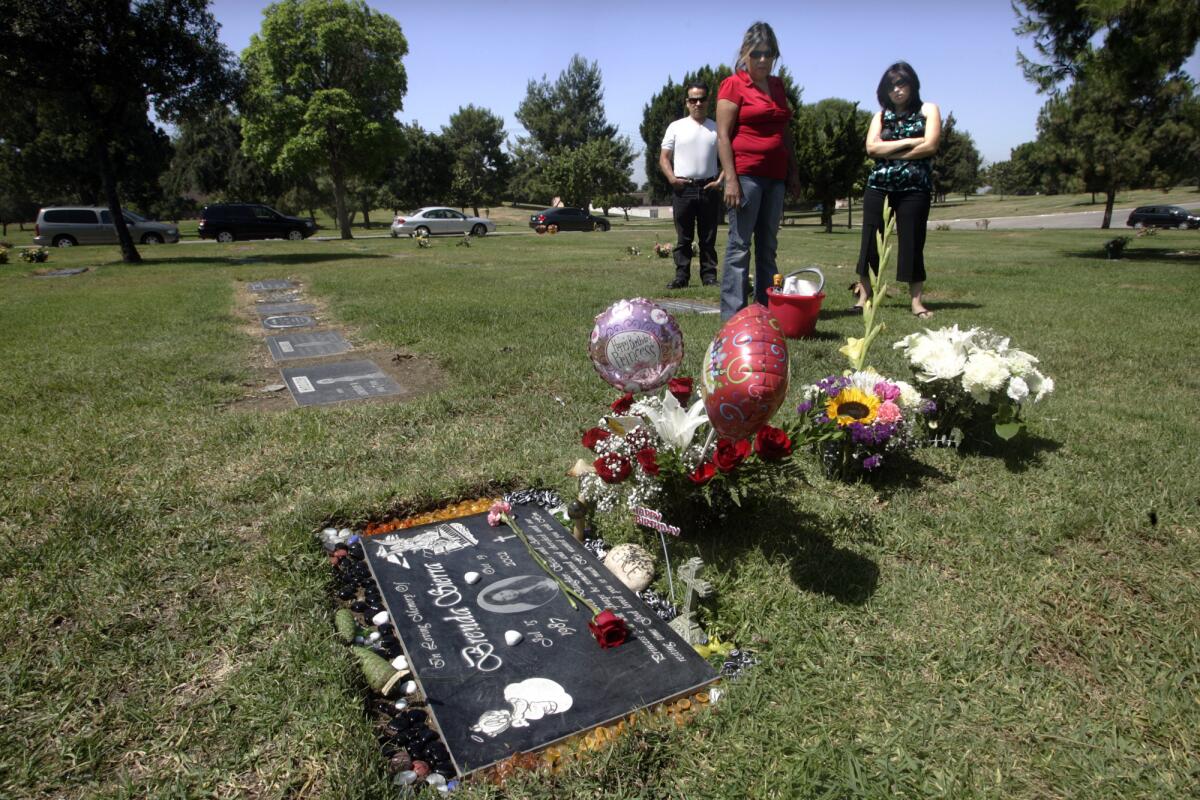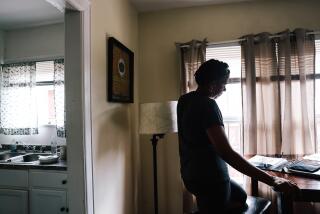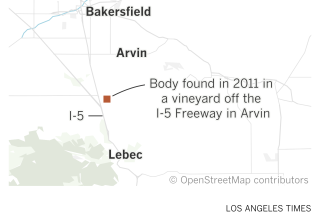Column One: A sister patiently waits for justice

Late at night, when the sky seems ominous and Fabiola Saavedra is curled up in bed lost in the past, her head fills with images of frantic searches down dark alleys, fliers posted in store windows and Polaroids of a lifeless face.
By morning, the ghosts are gone and Fabiola, 32, wakes up, kisses her husband and drives her two children to school. She heads to her job as a case manager at a senior citizens’ care center, where she greets clients and laughs loud and smiles big and makes lunch plans.
“I cry for her,” she says, the memory of her sister Brenda never far away. “But I have to move on.”
Sometimes, she tries to imagine what it would feel like if detectives called to say they had solved the mystery. Brenda was 15 when she disappeared on her way to school nearly seven years ago. Fabiola tells herself there is always reason to hope for a break in the case. DNA technology has advanced and the Los Angeles County supervisors recently renewed a $150,000 reward for information leading to a conviction.
Four different teams of detectives have worked the case over the years. They have all said the same thing: Finding the killer is a priority. Fabiola has always believed them.
So she waits.
::
Brenda Sierra tugged on a black backpack, slipped on a pair of brown Doc Martens, pushed open the metal screen door of her home and began walking north on Leonard Avenue in East Los Angeles.
The sophomore was on her way to catch a ride with her best friend, Ashley Salgado, to Schurr High School in Montebello. It was just after 7 a.m. on a Friday morning -- Oct. 18, 2002 -- and the walk to Ashley’s was less than five blocks.
When she didn’t arrive at the maize-colored house on Harding Avenue, Ashley and her mother assumed Brenda had found another ride or decided to stay home.
A teacher mistakenly marked her in attendance and it wasn’t until she failed to show up for a hair appointment that something seemed amiss. Brenda would not have skipped the opportunity to have her blond highlights retouched. Since her quinceanera less than three months earlier, she had been meticulous about her hair and makeup.
So when L.A. County sheriff’s deputies reacted mildly to the missing persons report that night, Fabiola began her own search.
She called Brenda’s friends and asked about her at restaurants, parks, laundromats. She organized family members, telling them to check hospitals and knock on doors. When night fell, she drove around in her gray sedan, stopping at alleys to nudge sleeping bodies or peer inside cars filled with dark shadows.
On Saturday, Fabiola prodded her family: Check trash bins, talk to shop owners, stop kids on the street. Someone has to have seen something. She made fliers with Brenda’s school picture and began canvassing the neighborhood.
The next day, she notified the media and repeatedly called the sheriff’s station. In desperation, she sought the help of a friend’s mother who claimed to have psychic abilities. Brenda was being held captive, the woman said.
On Monday morning, Fabiola’s street was lined with TV crews. There had been a report of a body found in the woods in Crestline in the San Bernardino Mountains. Fabiola did on-camera interviews, then got a call from detectives who asked her to go with them to San Bernardino County to look at photos of the body. The thought made her insides turn.
“Why me?” she asked. “Why not my mother? One of my two brothers? They’re strong.”
“No,” they said. “You’re the strong one.”
::
Fabiola was the first child born to Rafael and Imelda Sierra in Zacatecas, Mexico. Jaime arrived two years later. Maria came next. Then Brenda. Then Rafael Jr.
At 10, Fabiola found herself the second mother in the household.
By then they were living in East L.A., another immigrant family in a neighborhood where the rumble of the freeway was the soundtrack and the Maravilla gang the performers.
While her parents worked, Fabiola filled in the gaps -- making breakfast, changing diapers, reading books. Brenda latched on to her as a toddler, crawling into Fabiola’s bed at night and refusing to leave.
When Fabiola became pregnant at 16, she worried that 6-year-old Brenda would think less of her. So Fabiola finished high school, became a medical assistant and married her boyfriend, Sergio Saavedra. The two moved with their daughter into an apartment on Leonard Avenue.
The rest of the Sierras followed, renting a home a few houses away. The quiet block on the border of Montebello felt safe, an upgrade from their previous neighborhoods. Fabiola gave birth to a son three years later.
Brenda often crossed the street and made her way to Fabiola’s house, hoping to play with her niece and nephew, maybe get an invitation for dinner. Thin but always eating, Brenda was a tomboy known for taking five-minute showers and being more interested in sports than in guys. As a teenager, she began borrowing Fabiola’s clothes and shoes and listening to advice about fashion and hair. She begged her sister to teach her the latest dance moves.
One October evening in 2002, Brenda knocked on Fabiola’s door, upset about their parents’ recent separation. Fabiola hugged her sister and gave her a pair of red hoop earrings. It was the last time she saw her alive.
::
Fabiola said a silent prayer from the back of the squad car headed toward the San Bernardino County coroner’s office: I don’t mean to be selfish, but please don’t let it be my sister. Let it be someone else.
The body of a young girl with wavy brown hair had been found in the San Bernardino National Forest. She had been dumped fully clothed and face-down in an area known as the Valley of Enchantment. The cause of death was blunt-force trauma to the head.
Detectives led Fabiola into a tiny sheriff’s outpost and sat her down at a table before an envelope filled with photos of a girl with a smooth complexion and a bruise on her face.
Fabiola’s mind went blank, and everything was out of focus.
“Nope, not my sister,” she said pushing one picture aside.
“No,” she said of the next, “this is not her.” Each photo: No. No. No.
After she went through the stack, Fabiola sat and stared at the table.
A detective opened another envelope with belongings found on the victim. Inside was a gold chain necklace with a cross and a pair of red hoop earrings.
The items broke through Fabiola’s denial. They could not be wished away.
Moments passed. The room was quiet.
Finally, Fabiola pushed the photos aside, put her head on the table and cried.
::
On the Eastside, boys who play like men and roll with crews sometimes get shot. Innocent children standing on sidewalks can fall victim to wild gunfire.
But nice teenage girls who walk to school are usually safe. Which made Brenda Sierra’s case different, and harder to solve.
“I remember speaking to the first detectives that had the case. They said if your sister would’ve been affiliated to a gang or would’ve been a street girl, the killers would have” bragged about the killing, Fabiola says. “Since she was a good girl, it’s really hard.”
Strangers would stop members of the Sierra family on the street. “I’m so sorry,” they said. “How can we help?”
Brenda’s house was flooded with colorful bouquets, cards, posters and candles. Vigils were held and donations were offered to help bury a girl whose death was a mystery.
Neighborhood parents couldn’t help but clutch their children tightly and warn them to come right home.
Fabiola’s daughter is now 15. She’s a nice girl with brown eyes and long, wavy hair. Her mother doesn’t allow her to walk anywhere alone.
::
Jaime arrives first, just after 8 on a July morning, when the sun has already set the air on fire. He hides behind dark glasses and his black tank top reveals a tattoo of a crying Tasmanian devil and the words “R.I.P. Bren-Bren,” a tribute to his little sister. He totes a bundle of pink and white flowers to place on grave No. 148 at Resurrection Cemetery in Monterey Park.
Kneeling on the yellowed grass, he bows his head in silence and delivers a kiss with two fingers to the gray headstone. Below the earth lies a pink coffin.
Jaime was 23 when Brenda died. The years that followed were laced with cocaine and crystal meth and tumblerfuls of alcohol. He is clean now. Like everyone else in the family, he leaned on Fabiola.
“She’s always been the one taking charge of everything,” he says. “She’s the one you call when you’re in trouble. Even when you don’t want her there, she’s there.”
Jaime moved out of the house on Leonard Avenue shortly after Brenda’s death. They all did, scattering to cities across the San Gabriel Valley. Fabiola -- the voice for her Spanish-speaking parents and the rock for her siblings -- found herself relieved by the distance.
They see one another on occasions such as this, what would have been Brenda’s 22nd birthday.
When Rafael and Imelda Sierra pull up, it marks the second time the separated couple have visited Brenda’s grave together. Imelda busies herself cleaning the headstone with a paper towel and decorating its edges with handfuls of colorful stones. Rafael sits nearby, staring ahead.
By the time Fabiola arrives an hour later, Jaime has left for work and her parents have moved into the shade of a pine tree.
A few months ago, Fabiola went to the cemetery with her husband and children and couldn’t help but weep. But today she places two bouquets on the grave with dry eyes. “When my mom is here, I don’t break down at all,” she says. “I feel when I’m around her, I have to be the strongest.”
::
One day in early August, a homicide detective calls Fabiola to tell her he has a name.
Fabiola catches her breath, her heart rushing.
His name is Jorge Barraza, although he goes by “Trooper,” and he’s wanted for questioning. He is 29, the L.A. County sheriff’s investigator says, a member of an East L.A. gang who lived in the same neighborhood as the Sierra family when Brenda was alive.
The detective says Barraza is a “person of interest.” The Sheriff’s Department released his name and photo and asked for the public’s help in locating him. If deputies can find him, the detective says, they may get some answers.
He says he’ll stay in touch.
Fabiola hangs up, her hands shaky.
It is not much. Just a name. Still, she sobs and laughs and trembles and begins dialing family phone numbers, her hope alive again.
More to Read
Start your day right
Sign up for Essential California for news, features and recommendations from the L.A. Times and beyond in your inbox six days a week.
You may occasionally receive promotional content from the Los Angeles Times.







